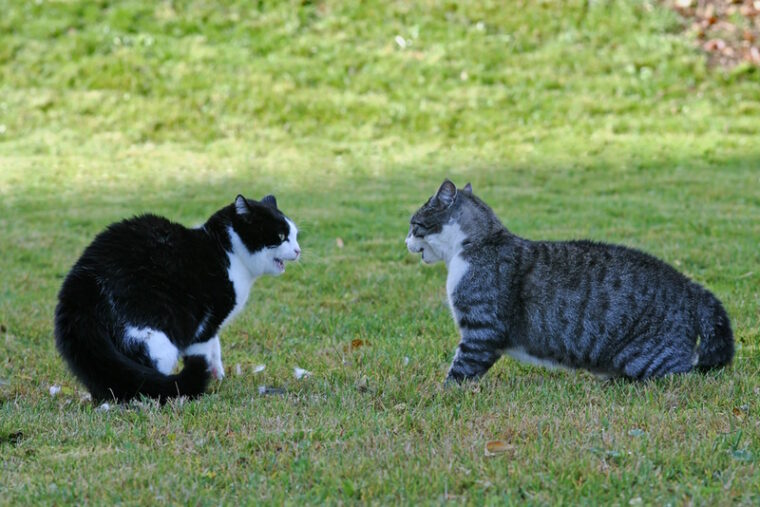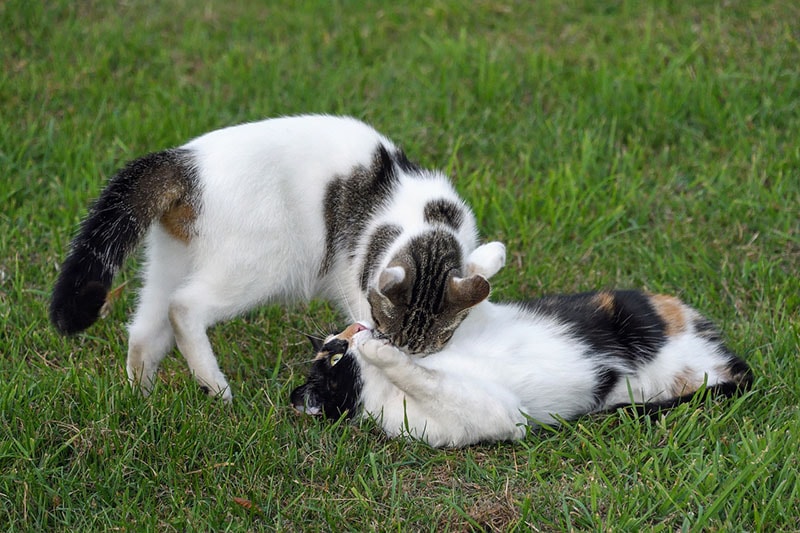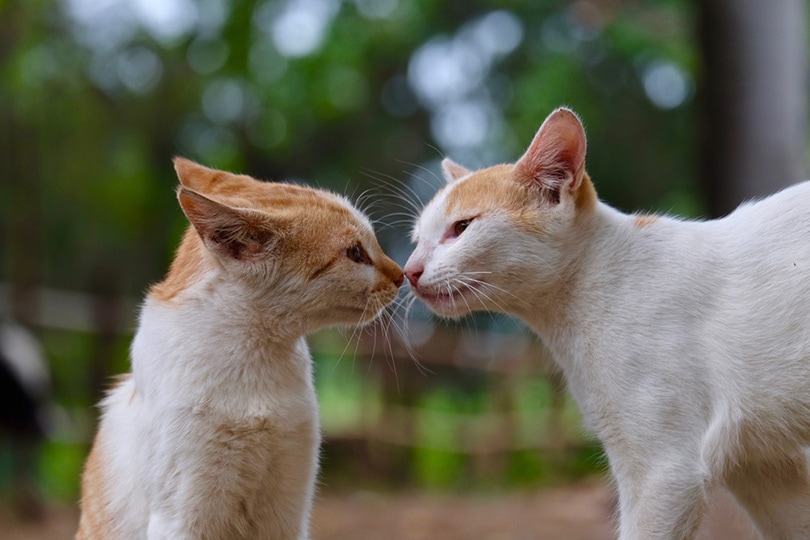
Unlike dogs, which display their feelings in exuberant, slobbering, tail-wagging ways, cats often seem determined to keep us guessing what they are thinking. When they meow at us, it could mean anything from, “I’m hungry!” to “Get off my couch!” Even purring, generally thought of as a sign of happiness, can also mean that a cat is stressed or not feeling well.
Humans may find cat communications baffling, but what about cats themselves? The primary ways that cats communicate with each other are with body language, scent marking, behavior, and vocalizations. Keep reading to learn more about how cats talk among themselves!
 Body Language
Body Language
Cats communicate with each other using body language. This involves the movement, position, and interaction of multiple body parts simultaneously. Many of these patterns and modes of communication are involuntary, whereas others can be consciously controlled by cats to some extent.
For cats, one of the keys to body language is their tails. Cats that feel calm and safe with each other will communicate that in part by keeping their tails up, often with just the tip twitching. They also communicate fear, anger, or uncertainty by tucking their tails or lashing them from side to side. These actions are often accompanied with other characteristics too. For example, a cat that’s feeling angry may lash their tail and have their hackles raised.
For pet owners, body language can provide some clues as to how cats interact within the home. The most intriguing points of observation are likely to occur in narrow spaces, such as doorways or hallways. For example, some cats may avoid eye contact with other cats in such a space, while others may deliberately stare at other cats passing through these narrow spaces as a sign of territorial display.
Cats that feel comfortable with another cat may indicate their approval and liking of each other by making eye contact and blinking slowly.
If a cat is more uncertain about another cat, they may move slowly, arch their back to appear bigger, or move down closer to the floor. Ears flattened to their heads or legs pulled close to their bodies indicate that a cat feels threatened enough to resort to aggressive behaviors. The other cat would be wise to remove themselves from this situation!

Scent Marking
Scent is one of the most important ways that cats communicate with each other. All cats have scent glands along their body, enabling them to leave their unique scent by rubbing these on objects, people, or other cats. When cats mark something with their scent, they are leaving pheromones, or chemical signals. These can be messages that say stuff like, “This territory is mine.” Or, in the case of a female in heat, might be something like, “Come and get me!”
Cats also leave their scent to mark their territory and make sure other cats know where it is and to stay out. In the best-case scenario, your indoor cat uses face rubbing to mark their territory; the other common way that cats communicate with scent is more undesirable: urine spraying.
Outdoor cats, especially males, spray urine to lay claim to their territory and warn other males to stay away. In some cases, indoor cats also spray. Most of the time, this happens when something is stressing the cat, such as a new cat in the house. Spraying is the first cat communicating ownership of their territory to the intruder.
Behavior
Cats use certain behaviors to communicate their feelings to each other. For example, cats display affection and sometimes, dominance by grooming and licking one another. Touching noses and rubbing their heads and bodies together are other ways that cats show acceptance and affection toward each other. Loving and friendly cats may even link their tails together, possibly akin to humans holding hands.
Besides grooming, cats may communicate dominance toward another cat by sitting on them, chasing them out of rooms or off furniture, or pushing them away from their food and water.
Some behaviors that cats use to indicate fear or aggression include stalking other cats, swatting or attacking them, or making angry vocalizations.

Vocalizations
Cats rely on vocal ways to communicate as much as they do on other methods. Over 21 different cat vocalizations have been documented in the literature.
Kittens meow to communicate hunger or discomfort to their mothers, but once cats grow up, they don’t use this method to talk to each other as much. Adult cats use meowing more to communicate with humans than they do each other.
Cats feel that humans must be spoken to in “baby talk” if we are going to understand them!
 Why You Should Care What Your Cats Say to Each Other
Why You Should Care What Your Cats Say to Each Other

Now you know more about how cats communicate, but why is it important? Take the time to watch your cats interact. What behaviors take on new meaning and give you more insight into your cats’ relationship?
Maybe you thought all that grooming was a sign that your cats were getting along great, not that one was bullying the other. Perhaps you just brought home a new cat and now recognize the signs of fear that your old cat is displaying.
Understanding how your cats communicate helps you recognize when they might be having problems before they escalate. Behavior issues are partly why many family cats end up surrendered to animal shelters. The sooner any potential problems are recognized, the better the chance you have of fixing them.
If you are concerned about your cats’ behavior toward other cats or even humans, reach out to your veterinarian. They will be able to help you evaluate your cat, diagnose any possible medical conditions that could be contributing, and even refer you to an animal behavior specialist if needed.
 Conclusion
Conclusion
Communication is complicated, whether it is between cats or humans. Even with our gift of speech, humans can have a hard time understanding each other sometimes. Understanding what cats are saying, especially to each other, can be even harder. However, it can be a key factor in making sure our cats are living happy, stress-free lives. Taking the time to learn how cats talk to each other can improve your bond with your pets and even help you find new ways to communicate with them yourself!
You may also be interested in:
Featured Image Credit: Astrid Gast, Shutterstock


 Body Language
Body Language Why You Should Care What Your Cats Say to Each Other
Why You Should Care What Your Cats Say to Each Other



